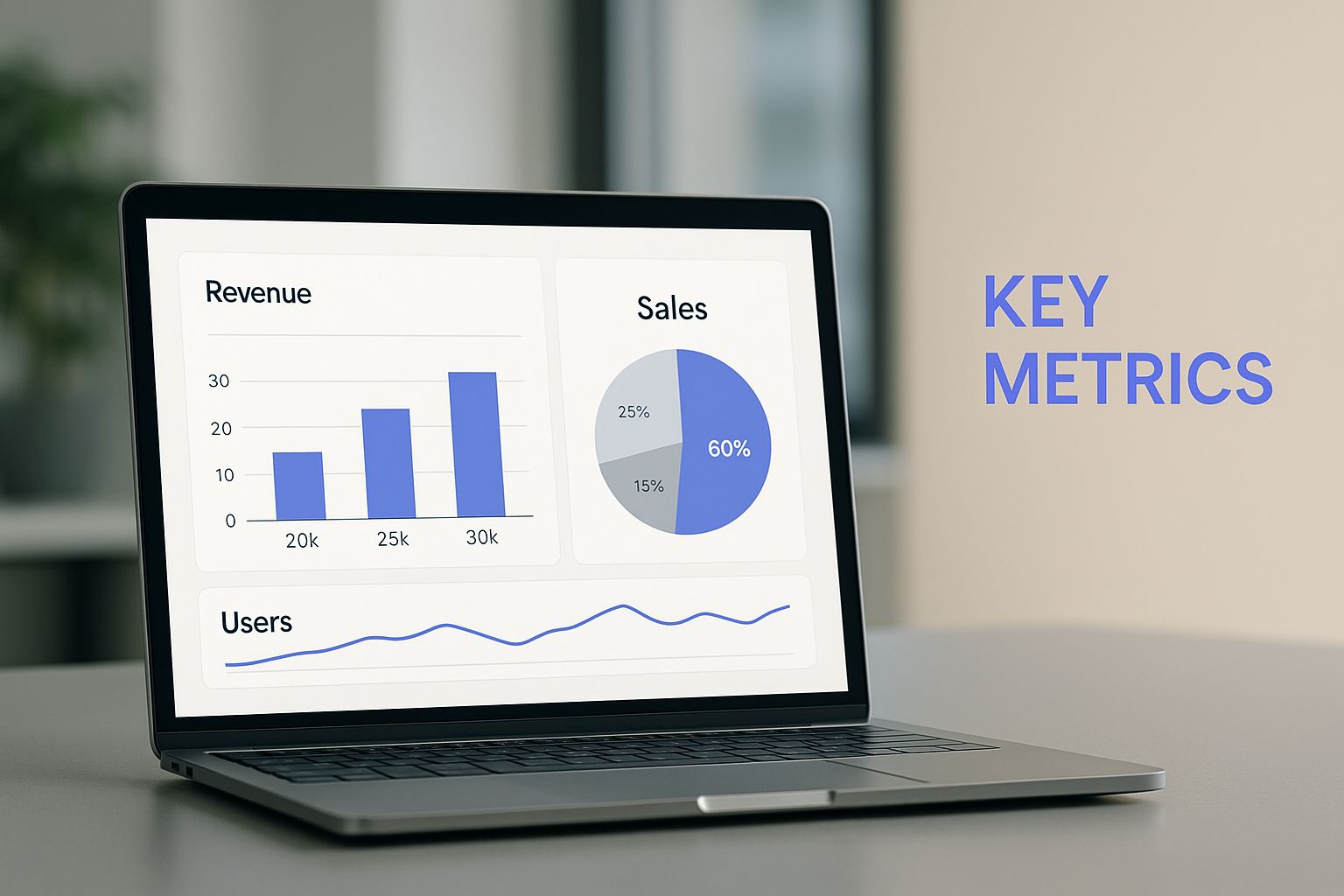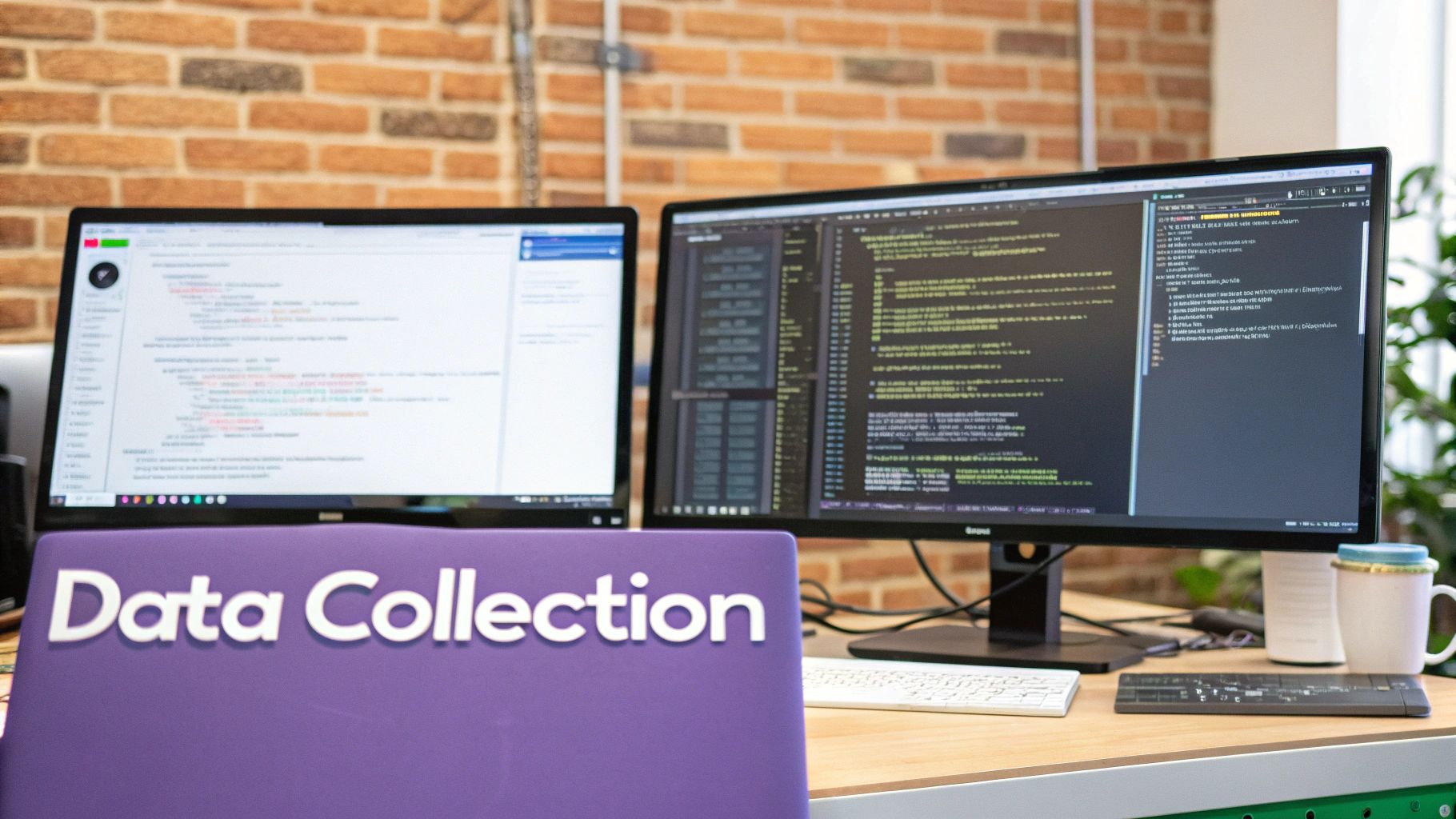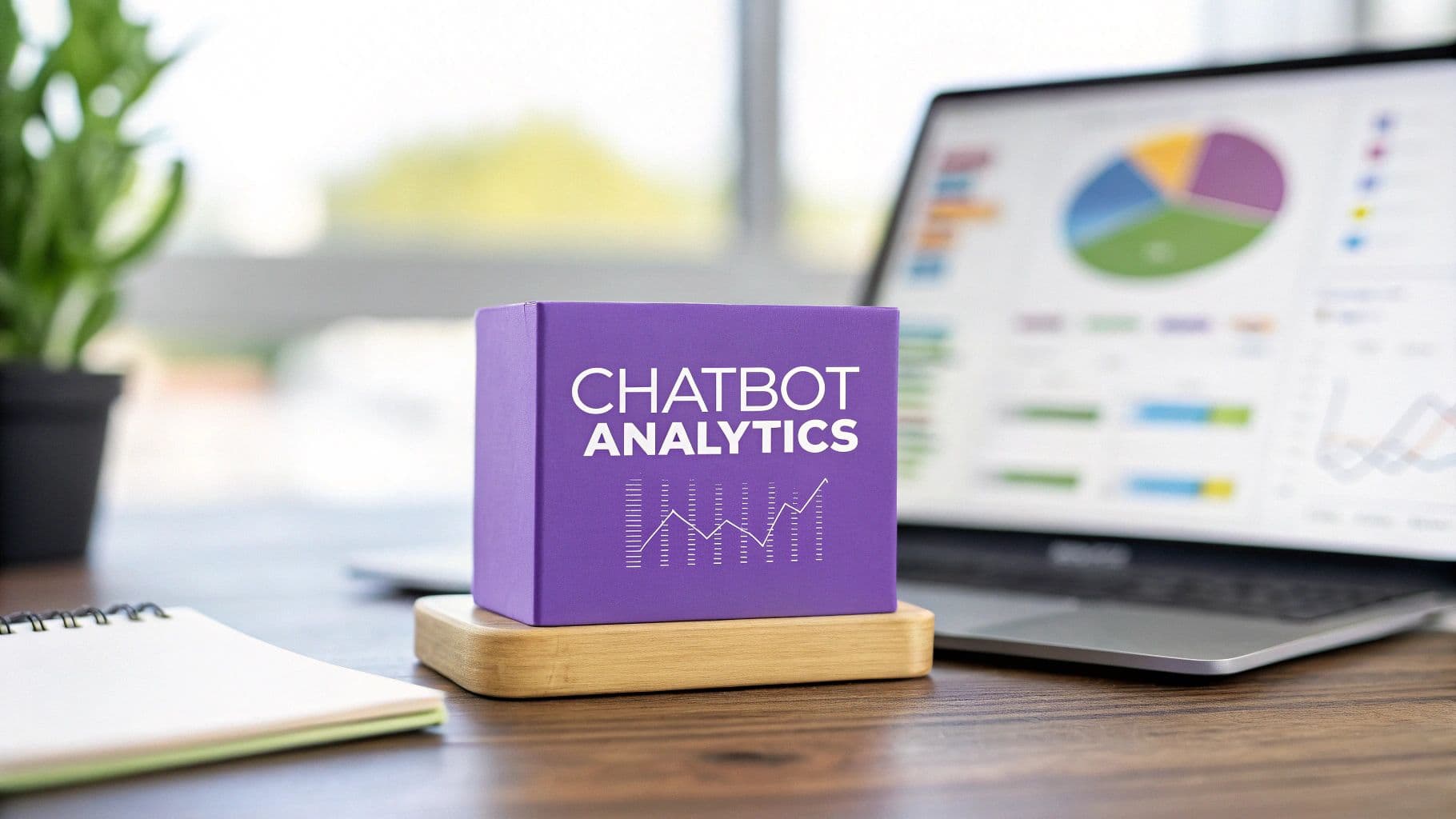The Strategic Power of Analytics for Chatbots
Chatbots have evolved beyond simple automation. They're now valuable business assets, offering key insights into customer behavior and driving measurable results. By using chatbot analytics and customer interaction analytics, companies can transform customer interactions into opportunities for growth and improvement. Smart businesses are already using this conversational data to understand customer journeys, identify pain points, and personalize experiences. This strategic approach is what separates thriving chatbot programs from those that fall short.
Understanding the Value of Chatbot Data
The move towards data-driven chatbot strategies is fueled by the rapid growth of the chatbot market. Valued at approximately $5.4 billion in 2023, the global chatbot market is projected to reach $10.32 billion by 2025. That's a compound annual growth rate (CAGR) of 24.8%. This impressive growth is driven by advancements in natural language processing (NLP), improved customer engagement, and cost-effective customer service.
Over 80% of companies worldwide already use some form of chatbot technology. By 2029, the market is expected to reach a staggering $29.5 billion. Find more detailed statistics here. This widespread adoption shows how essential chatbots have become. But just having a chatbot isn't enough. The real value lies in analyzing the data it generates.
Key Benefits of Implementing Analytics
The right analytics framework has a direct impact on your bottom line. Analyzing conversation flows, for instance, can pinpoint where users abandon interactions. Sentiment analysis helps gauge customer satisfaction and identify areas for improvement.
These insights allow you to optimize your chatbot strategies. This leads to:
- Increased customer satisfaction
- Improved conversion rates
- Reduced support costs
Ultimately, this strengthens customer loyalty and fuels business growth.
Building a Foundation for Success
A solid analytical foundation is essential for maximizing chatbot effectiveness. This includes selecting suitable analytics platforms, defining key performance indicators (KPIs), and implementing robust data collection strategies.
A well-defined analytics strategy empowers you to:
- Monitor chatbot performance
- Identify areas for optimization
- Measure the return on investment (ROI) of your chatbot initiatives benefits of using AI chatbots for business growth
Furthermore, it enables data-driven decisions that continuously improve the customer experience and drive business value. Strategic use of chatbot analytics gives businesses a competitive advantage in today’s dynamic market.
Essential Metrics That Drive Chatbot Performance

The infographic above showcases a modern digital dashboard displaying essential chatbot metrics. This visual provides a clear overview of the crucial data points businesses need to track for effective chatbot management. The dashboard's clear design underscores the importance of a comprehensive and balanced measurement approach to extract actionable insights.
Effective chatbot analytics isn't just about gathering data; it's about focusing on the metrics that truly drive performance. You can also explore our Instagram screenshot notifications deep dive for an example of detailed metric reporting in a different context. This involves understanding how different measurements work together to tell the complete story of your chatbot's effectiveness. By examining these metrics, you can pinpoint areas for improvement and ensure your chatbot contributes to your business objectives. You might find this interesting: How to master your sitemap.
User Engagement Metrics
User engagement metrics offer valuable insights into how users interact with your chatbot. These measurements reveal how effective your chatbot is at communicating and meeting user needs. Analyzing engagement is crucial for optimizing the user experience and ensuring user satisfaction.
-
Conversation Completion Rate: This metric measures the percentage of conversations successfully completed by the chatbot. A high completion rate suggests that the chatbot is effectively addressing user queries and providing satisfactory solutions. Conversely, a low rate may point to potential issues or confusion within the conversation flow.
-
User Retention: This tracks how frequently users return to engage with your chatbot. High user retention indicates a positive user experience and the chatbot's ability to deliver consistent value.
-
Sentiment Scores: By analyzing the emotional tone of user interactions, sentiment scores provide insight into user satisfaction. Positive sentiment generally signifies a well-performing chatbot, while negative sentiment highlights areas that require attention and improvement.
Operational Efficiency Metrics
Operational efficiency metrics focus on the chatbot's performance from a resource utilization standpoint. These metrics help you streamline operations and uncover opportunities for cost savings. Improving efficiency leads to better resource allocation and a more effective chatbot strategy.
-
Resolution Rates: This metric measures the chatbot's ability to resolve user issues without human intervention. A high resolution rate translates to improved customer service efficiency and reduced operational costs.
-
Handling Time: This measures how long it takes for the chatbot to complete an interaction. Optimizing handling time improves efficiency and allows the chatbot to handle a greater volume of user requests.
-
Escalation Patterns: Examining escalation patterns reveals common reasons why conversations require human intervention. This information helps refine chatbot responses and minimize the need for escalations.
Business Impact Metrics
Business impact metrics directly link chatbot performance to business outcomes. These metrics demonstrate the return on investment (ROI) of your chatbot and its contribution to your overall business goals. This data-driven approach facilitates informed decision-making and strategic enhancements.
To provide a comprehensive overview, let's look at the following table:
High-Impact Analytics for Chatbots Framework
A comprehensive view of the metrics that matter most across engagement, operations, and business outcomes - with implementation guidance for each category
| Metric Category | Key Metrics | Measurement Approach | Business Impact |
|---|---|---|---|
| User Engagement | Conversation Completion Rate | Track completed conversations vs. total conversations | Improved user satisfaction, reduced friction |
| User Retention | Monitor returning users over time | Increased engagement, higher customer lifetime value | |
| Sentiment Scores | Analyze text for positive, negative, or neutral sentiment | Better understanding of user perception, identification of pain points | |
| Operational Efficiency | Resolution Rates | Track resolutions without human intervention | Improved efficiency, lower support costs |
| Handling Time | Measure average interaction duration | Streamlined operations, increased capacity | |
| Escalation Patterns | Analyze reasons for human intervention | Refined chatbot responses, reduced escalations | |
| Business Impact | Conversion Lift | Compare conversion rates with and without chatbot | Demonstrates chatbot's contribution to revenue generation |
| Cost Savings | Calculate reduction in support costs | Quantifies financial benefits of chatbot implementation | |
| Satisfaction Improvement | Compare customer satisfaction before and after chatbot | Enhanced customer experience, increased loyalty |
This table summarizes the key metrics across different categories, providing a framework for measuring and improving chatbot performance. By focusing on these metrics, businesses can ensure their chatbots are not only efficient but also contribute to their bottom line.
-
Conversion Lift: This metric measures how the chatbot influences conversions, such as sales or lead generation. A positive conversion lift demonstrates the chatbot's effectiveness in driving desired business results.
-
Cost Savings: Automating tasks previously handled by human agents can result in significant cost savings. This metric quantifies the financial benefits of implementing a chatbot. For more on cost analysis, refer to the Intercom chatbot pricing guide.
-
Satisfaction Improvement: Comparing customer satisfaction scores before and after chatbot implementation highlights the positive impact on the customer experience. This improvement can contribute to increased customer loyalty and retention. A higher satisfaction score often correlates with higher customer lifetime value.
Building Your Chatbot Analytics Ecosystem
Building a robust analytics ecosystem for your chatbot is essential for maximizing its effectiveness. Deploying a chatbot is just the first step. Understanding how users interact with it and how it contributes to your business goals is where the real value lies. This requires a strategic approach to selecting the right platforms, implementing effective tagging strategies, and ensuring data quality. Additionally, leveraging WhatsApp CRM integration can unify customer messaging data for more comprehensive insights. It's like constructing a building: a strong foundation is critical for long-term stability and success.
Choosing the Right Analytics Platform
Choosing the right analytics platform is the first crucial step. Consider whether your current chatbot platform offers built-in analytics or if a third-party solution like Google Analytics is necessary. Built-in analytics can be convenient for basic tracking, such as conversation volume. However, they may lack the depth and flexibility of dedicated platforms. Third-party solutions often provide more advanced features.
Some of these advanced features include:
- Customizable dashboards
- Sentiment analysis
- Conversation flow visualization
Select the platform that best aligns with your specific needs and integrates seamlessly with your existing systems.
Tagging and Data Collection
Once you've chosen your platform, implement a tagging strategy to collect meaningful data. Tags act as labels assigned to different parts of a conversation. This allows you to track specific user interactions and identify important trends. For example, you could tag user inquiries related to specific topics:
- Product Information
- Shipping
- Returns
This granular data provides valuable insights into user behavior, which allows you to optimize your chatbot's responses.
Maintaining Data Quality
Ensuring data quality is paramount. Inaccurate data can lead to flawed analysis and ultimately, poor decisions. Implement measures to validate data accuracy and address any discrepancies. This might include:
- Regular data audits
- Automated data cleaning processes
- Clear data governance policies
Clean data is essential for generating actionable insights, just as fresh ingredients are essential for a chef to create a delicious meal. Chatbots are now integral to many industries, especially retail, finance, and healthcare. In retail, 40% of U.S. consumers use chatbots for customer service interactions. Find more detailed statistics here.
Overcoming Technical Challenges
Building an analytics ecosystem can present technical challenges. Integrating different platforms, managing data storage, and ensuring data security require careful planning and execution. Successfully navigating these challenges is key to unlocking the full potential of your chatbot analytics. For insights into applying marketing analytics in other areas, explore the power of Marketing Analytics in SMS Campaigns.
Built-in vs. Third-Party Solutions
Built-in chatbot analytics typically offer basic metrics like conversation volume, completion rates, and user satisfaction. These metrics are a solid starting point, particularly for smaller businesses. However, as your chatbot usage grows, the advanced features of a third-party solution may become necessary. For example, if you want to use sentiment analysis to understand user emotions or analyze conversation flow to identify bottlenecks, a dedicated platform might be a better choice.

This meticulous approach is the foundation for obtaining valuable insights and implementing data-driven optimization. By carefully selecting platforms, implementing tagging strategies, and maintaining high data quality, businesses can build a truly impactful chatbot strategy. From this well-built analytics ecosystem, you can glean the insights that drive continuous improvement and achieve significant business results.
Conversation Flow Analysis: Where Insights Meet Action
Beneath every chatbot interaction lies a treasure trove of data waiting to be discovered. Analyzing conversation patterns reveals the true nature of your customer experience, highlighting pain points and areas for improvement. This analysis pinpoints where users abandon conversations and uncovers the issues that cause frustration.
By understanding these patterns, businesses can optimize their chatbots for better performance and happier users. This translates raw data into actionable changes, resulting in a more positive and efficient experience for everyone.
Mapping User Journeys and Identifying Bottlenecks
Leading companies use conversation flow analysis to map user journeys within their chatbots. This involves visualizing how users navigate the chatbot's dialogue options, much like tracing a route on a map. This process helps identify bottlenecks, those points where users get stuck or give up.
For example, if a significant number of users abandon the conversation at a specific question, it indicates a problem with that step. Identifying these friction points is crucial for optimizing the conversation flow and guiding users toward successful outcomes, ultimately improving customer satisfaction.
Transforming Insights into Improved Designs
Identifying bottlenecks is just the beginning. The true value lies in using these insights to refine the chatbot’s conversational design. This might involve simplifying complex questions, providing clearer instructions, or offering alternative conversational pathways.
Imagine a pizza-ordering chatbot. If users consistently struggle to select toppings, a redesign might replace a text-based list with a visual menu. This directly addresses the bottleneck and simplifies the ordering process. This iterative cycle of analysis and improvement is key to maximizing chatbot effectiveness.
Visualizing Interaction Data for Actionable Insights
Visualizing complex interaction data makes chatbot analytics understandable for everyone involved. Clear visualizations, such as flowcharts and heatmaps, bridge the communication gap between technical teams and business stakeholders.
These visual representations clarify user behavior and highlight areas for improvement. A heatmap might reveal the most frequent paths within a conversation, while a flowchart illustrates the entire user journey. This shared understanding fosters collaboration and empowers data-driven decisions. These accessible insights help businesses translate raw data into meaningful action, continuously optimizing chatbot performance. Chatbot efficiency and user preference are significant factors in their increasing adoption. Currently, chatbots manage approximately 70% of conversations from start to finish, resulting in a 30% reduction in customer support costs and 80% faster response times. Explore this topic further.
Practical Examples of Conversation Flow Analysis in Action
Many companies successfully employ conversation flow analysis. For instance, an e-commerce business might analyze chatbot conversations to understand cart abandonment rates. By pinpointing the specific friction point, they can tailor the chatbot's responses to address customer concerns and encourage purchase completion.
Another example is a bank using conversation flow analysis to streamline customer support. By identifying frequently asked questions, they can design the chatbot to provide quick, accurate answers, minimizing wait times and boosting customer satisfaction. This practical application of data analysis empowers businesses to continually optimize their chatbots for maximum impact.
By implementing these techniques, companies can make conversation analytics accessible and actionable for everyone involved in the chatbot program, from developers to marketing teams. This collaborative, data-driven approach ensures the chatbot continually evolves to meet customer needs and achieve business objectives. It's the key to unlocking the full potential of chatbots as valuable business tools.
Turning Analytics Into Competitive Advantage

Simply monitoring your chatbot's data isn't enough. To truly unlock its potential, you need active optimization. This means transforming raw analytics into tangible business improvements with WhatsApp Business AI analytics. It's about understanding how to turn insights into action and building a culture of continuous improvement around your chatbot program. This approach elevates chatbots from basic automation to strategic business tools.
Prioritizing Improvements Based on Impact Potential
Successful chatbot optimization requires a systematic approach. The first step is identifying areas where improvements will yield the greatest impact.
For example, if your analytics reveal high abandonment rates at a specific point in the conversation flow, focusing your optimization efforts there will likely result in significant gains. Prioritize changes based on data, not just intuition.
A/B Testing and Measuring ROI
A/B testing is a crucial technique for optimizing conversational elements. It involves creating two versions of a chatbot interaction, each with a slightly different approach. By comparing their performance, you can identify the most effective version.
For instance, testing different phrasing for a key question can reveal the best way to guide users towards a desired outcome. Measuring the return on investment (ROI) of your optimization efforts ensures that changes produce positive business results.
Tracking key metrics, like conversion rates and customer satisfaction, before and after implementing changes demonstrates the value of optimization. This data-driven approach keeps you focused on the most impactful changes.
Establishing Feedback Loops Between Teams
A strong connection between analytics and development teams is vital for continuous improvement. Create feedback loops where data insights inform chatbot development and vice versa.
Sharing analytics reports with developers, for example, can help them understand user behavior. This shared understanding helps identify areas for refining the chatbot's functionality. Developers can also provide feedback on the feasibility of implementing specific changes, considering the technical constraints of the chatbot platform.
To effectively visualize and analyze this data, consider using tools like Google Analytics or dedicated chatbot analytics platforms.
Building a Culture of Continuous Improvement
Cultivating a culture of continuous improvement around your chatbot program is paramount for long-term success. This means establishing processes for regularly reviewing analytics, identifying areas for optimization, and implementing changes. This constant iteration ensures your chatbot adapts to evolving user needs and remains a valuable asset.
Regular meetings to discuss chatbot performance and brainstorm optimization strategies can foster a collaborative approach to improvement. This allows all team members to contribute to the optimization process.
Gaining Stakeholder Buy-in and Demonstrating Value
Demonstrating the value of incremental enhancements is crucial for gaining stakeholder buy-in. Showing how small changes can significantly improve key metrics like conversion rates or customer satisfaction reinforces the importance of ongoing optimization. This justifies continued investment in the chatbot program.
Clear communication and data-driven evidence are essential for conveying the value of these efforts.
To help illustrate how to translate insights into action, let's look at a practical roadmap:
From Data to Results: The Chatbot Optimization Roadmap A proven framework for translating analytics insights into specific chatbot improvements, with implementation guidance for organizations at any maturity level.
| Analytics Insight Type | Potential Actions | Implementation Complexity | Expected Impact |
|---|---|---|---|
| High Abandonment Rate at Specific Step | Clarify chatbot language, offer alternative navigation options, simplify the step | Low to Medium | High (improved completion rates) |
| Low Conversion Rate on Key Goal | Refine call-to-actions, personalize messaging, offer incentives | Medium | Medium to High (increased conversions) |
| Negative User Feedback on Specific Feature | Redesign the feature flow, adjust chatbot tone, provide additional support resources | Medium to High | Medium (improved user satisfaction) |
| Low Usage of a Specific Feature | Promote the feature within the chatbot flow, improve its visibility, highlight its benefits | Low | Low to Medium (increased feature adoption) |
This roadmap provides a starting point for translating your analytical findings into actionable improvements. Remember that the specific actions and complexity will vary depending on your chatbot's functionality and your overall goals. By systematically addressing these insights, you can ensure your chatbot continues to deliver value and meet evolving user needs.
Next-Generation Analytics for Chatbots
The future of optimizing your chatbot interactions hinges on advanced analytics. Leading organizations are already leveraging AI-powered analytics to gain a deeper understanding of user behavior. This allows them to anticipate customer needs and craft truly personalized experiences. It's not just about gathering data; it's about transforming that data into actionable insights. These insights can then be used to build adaptive chatbots that continuously improve with every interaction. Forward-thinking companies are building these analytical capabilities today to secure a competitive advantage for tomorrow.
Sentiment Analysis: Measuring Emotional Responses
Sentiment analysis delves deeper than simply comprehending the words customers use. It analyzes the emotional tone behind those words, providing valuable insight into customer satisfaction, frustration, and their overall chatbot experience. Imagine a customer expressing negative sentiment about a recent purchase. The chatbot, equipped with sentiment analysis, could offer immediate support or even escalate the issue to a human representative. This real-time understanding of customer emotions allows businesses to address concerns proactively and efficiently. Similar to the methods described in this helpful article on analyzing customer feedback, understanding the emotional tone of your customer interactions is key to improving your business.
Intention Prediction: Anticipating User Needs
Taking analytics a step further, intention prediction models aim to anticipate user needs before they are explicitly stated. These models use machine learning to analyze past interactions and identify patterns suggesting a user’s likely goal. This allows chatbots to proactively offer relevant information or guidance, streamlining the interaction and creating a smoother user experience. For example, if a user frequently asks about shipping costs, an intention prediction model could recognize this pattern. In future interactions, the chatbot could proactively provide shipping information upfront. This proactive approach greatly improves customer satisfaction and interaction efficiency.
Behavioral Clustering: Personalized Conversation Paths
Behavioral clustering involves analyzing user interactions to group users with similar behaviors. This segmentation allows businesses to tailor conversation paths for specific user groups, leading to more personalized and relevant experiences. For example, if a group of users consistently uses the chatbot to track orders, the chatbot can be optimized to prioritize order tracking information for those users. This personalized approach results in more meaningful interactions and increases user engagement.
Adaptive Chatbots: Continuously Improving Through Interaction
These advanced analytic techniques contribute to the development of adaptive chatbots. These chatbots continuously learn and evolve based on the data they collect. They adapt their responses, conversational flow, and even the information they present to best suit user needs. This constant feedback loop is crucial for maximizing chatbot performance and providing a continually improving user experience. It's similar to a personal shopper who learns your preferences over time and anticipates your needs with each visit.
Building the Analytical Foundations for the Future
Establishing the right analytical foundation is crucial for harnessing the full potential of next-generation chatbots. This involves not just implementing the right tools, but also fostering a data-driven culture within your organization. Your team needs to be trained to understand and utilize the valuable insights generated by these advanced analytics. Companies investing in these foundations today will be well-positioned for success in the future of chatbot technology. This proactive approach ensures your chatbot remains a valuable asset. These improvements are not just about enhancing the user experience; they are about building a lasting competitive advantage. By offering personalized, proactive support, businesses can foster customer loyalty, increase conversions, and solidify their position as industry leaders.
Future-Proofing Your Chatbot Analytics Strategy
Staying ahead in the ever-evolving world of chatbot technology requires a deep understanding of emerging analytics trends. These advancements are changing how we measure and optimize chatbot performance, pushing the boundaries of what's possible. Preparing your analytics infrastructure today is crucial for gaining a competitive edge tomorrow.
Beyond Text: The Rise of Voice Analytics
Voice interactions are becoming increasingly common. This shift expands chatbot analytics beyond text, presenting new challenges and opportunities. Voice analytics focuses on elements like tone, pace, and pauses in spoken conversations. These factors offer deeper insights into user emotions and intent, enriching the data available for analysis.
This means businesses can develop a more nuanced understanding of user behavior, leading to more effective chatbot optimization. Imagine being able to understand not just what a customer is saying, but how they're saying it. That's the power of voice analytics.
Multimodal Analytics: Combining Visual and Textual Inputs
The future of chatbot interactions is multimodal, incorporating visuals like images and videos alongside text. Multimodal analytics tackles the complexity of analyzing these combined inputs, providing a richer understanding of user interactions.
For example, a customer might send a picture of a damaged product to a support chatbot. Multimodal analytics allows the chatbot to process both the image and the accompanying text. This enables a more efficient and accurate resolution, improving the overall customer experience.
Emotional Intelligence Metrics: Measuring Effectiveness
Understanding user emotions is critical for effective chatbot design. Emotional intelligence metrics, powered by AI, are becoming central to evaluating chatbot performance.
These metrics go beyond basic sentiment analysis by recognizing and interpreting complex emotional states. This allows chatbots to respond with greater empathy and tailor interactions to individual emotional needs. This nuanced approach strengthens user engagement and builds stronger customer relationships.
Cross-Channel Analytics: Connecting the Customer Journey
Customers interact with businesses across multiple channels. Cross-channel analytics connects chatbot conversations to broader customer journeys, offering a holistic view of user behavior.
This provides businesses with a complete picture of customer interaction, from initial contact on social media to a final purchase through a website chatbot. This integrated data allows for more effective personalization and targeted marketing strategies.
Privacy-Preserving Analytics: Adapting to Regulatory Changes
Data privacy is a growing concern. Privacy-preserving analytics techniques are evolving to adapt to regulatory changes, ensuring responsible data handling.
These techniques involve methods like data anonymization and differential privacy. This allows businesses to gain valuable insights from data without compromising user privacy. This ethical approach builds user trust and ensures compliance with evolving privacy regulations.
Real-Time Capabilities: Enabling Dynamic Conversation Management
Real-time analytics provides immediate feedback on chatbot performance, enabling dynamic conversation management. This allows businesses to identify and address issues as they arise, rather than relying on post-interaction analysis.
For example, if a chatbot detects negative sentiment in real time, it can adjust its responses mid-conversation. This dynamic approach ensures smoother interactions and maximizes customer satisfaction. Real-time data also allows for quick adaptation to changing circumstances, ensuring the chatbot remains effective and responsive. These capabilities are transforming chatbot optimization, enabling businesses to create truly personalized and responsive customer experiences.



